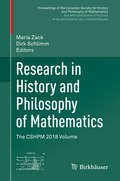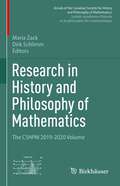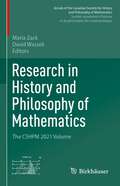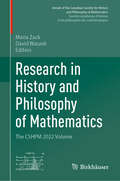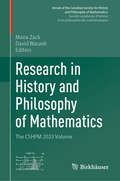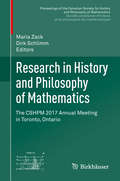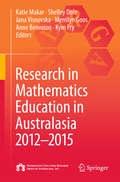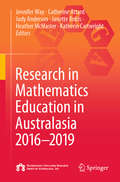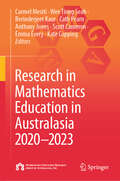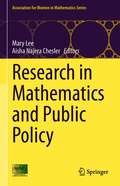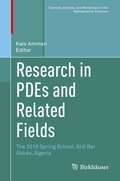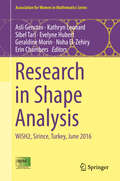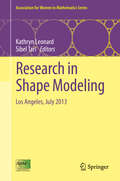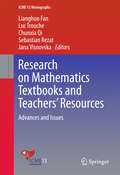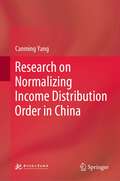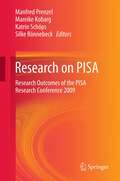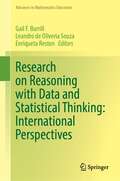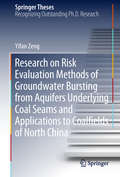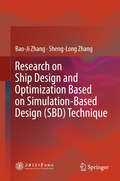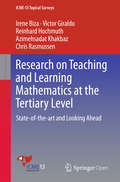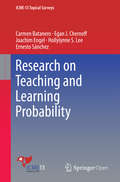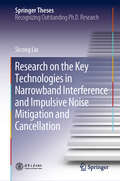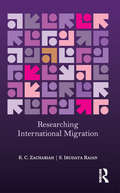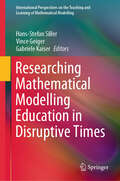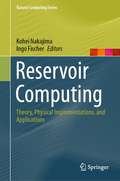- Table View
- List View
Research in History and Philosophy of Mathematics: The CSHPM 2018 Volume (Proceedings of the Canadian Society for History and Philosophy of Mathematics/ Société canadienne d’histoire et de philosophie des mathématiques)
by Maria Zack Dirk SchlimmThis volume contains ten papers that have been collected by the Canadian Society for History and Philosophy of Mathematics/Société canadienne d’histoire et de philosophie des mathématiques. It showcases rigorously-reviewed contemporary scholarship on an interesting variety of topics in the history and philosophy of mathematics from the seventeenth century to the modern era.The volume begins with an exposition of the life and work of Professor Bolesław Sobociński. It then moves on to cover a collection of topics about twentieth-century philosophy of mathematics, including Fred Sommers’s creation of Traditional Formal Logic and Alexander Grothendieck’s work as a starting point for discussing analogies between commutative algebra and algebraic geometry. Continuing the focus on the philosophy of mathematics, the next selections discuss the mathematization of biology and address the study of numerical cognition. The volume then moves to discussing various aspects of mathematics education, including Charles Davies’s early book on the teaching of mathematics and the use of Gaussian Lemniscates in the classroom. A collection of papers on the history of mathematics in the nineteenth century closes out the volume, presenting a discussion of Gauss’s “Allgemeine Theorie des Erdmagnetismus” and a comparison of the geometric works of Desargues and La Hire. Written by leading scholars in the field, these papers are accessible not only to mathematicians and students of the history and philosophy of mathematics, but also to anyone with a general interest in mathematics.
Research in History and Philosophy of Mathematics: The CSHPM 2019-2020 Volume (Annals of the Canadian Society for History and Philosophy of Mathematics/ Société canadienne d’histoire et de philosophie des mathématiques)
by Maria Zack Dirk SchlimmThis volume contains eleven papers that have been collected by the Canadian Society for History and Philosophy of Mathematics/Société canadienne d’histoire et de philosophie des mathématiques. It showcases rigorously-reviewed contemporary scholarship on an interesting variety of topics in the history and philosophy of mathematics, as well as the teaching of the history of mathematics. Topics considered includeThe mathematics and astronomy in Nathaniel Torperly’s only published work, Diclides Coelometricae, seu valvae astronomicae universalConnections between the work of Urbain Le Verrier, Carl Gustav Jacob Jacobi, and Augustin-Louis Cauchy on the algebraic eigenvalue problemAn evaluation of Ken Manders’ argument against conceiving of the diagrams in Euclid’s Elements in semantic termsThe development of undergraduate modern algebra courses in the United StatesWays of using the history of mathematics to teach the foundations of mathematical analysisWritten by leading scholars in the field, these papers are accessible not only to mathematicians and students of the history and philosophy of mathematics, but also to anyone with a general interest in mathematics.
Research in History and Philosophy of Mathematics: The CSHPM 2021 Volume (Annals of the Canadian Society for History and Philosophy of Mathematics/ Société canadienne d’histoire et de philosophie des mathématiques)
by Maria Zack David WaszekThis volume contains eighteen papers that have been collected by the Canadian Society for History and Philosophy of Mathematics. It showcases rigorously-reviewed contemporary scholarship on an interesting variety of topics in the history and philosophy of mathematics, as well as the teaching of the history of mathematics. Some of the topics explored includeArabic editions of Euclid’s Elements from the thirteenth century and their role in the assimilation of Euclidean geometry into the Islamic intellectual traditionPortuguese sixteenth century recreational mathematics as found in the Tratado de Prática Darysmetica A Cambridge correspondence course in arithmetic for women in England in the late nineteenth centuryThe mathematical interests of the famous Egyptologist Thomas Eric (T. E.) Peet The history of Zentralblatt für Mathematik and Mathematical Reviews and their role in creating a publishing infrastructure for a global mathematical literatureThe use of Latin squares for agricultural crop experiments at the Rothamsted Experimental StationThe many contributions of women to the advancement of computing techniques at the Cavendish Laboratory at the University of Cambridge in the 1960sThe volume concludes with two short plays, one set in Ancient Mesopotamia and the other in Ancient Egypt, that are well suited for use in the mathematics classroom.Written by leading scholars in the field, these papers are accessible not only to mathematicians and students of the history and philosophy of mathematics, but also to anyone with a general interest in mathematics.
Research in History and Philosophy of Mathematics: The CSHPM 2022 Volume (Annals of the Canadian Society for History and Philosophy of Mathematics/ Société canadienne d’histoire et de philosophie des mathématiques)
by Maria Zack David WaszekThis volume contains 8 papers that have been collected by the Canadian Society for History and Philosophy of Mathematics. It showcases rigorously reviewed contemporary scholarship on an interesting variety of topics in the history and philosophy of mathematics.Some of the topics explored include:A way to rethink how logic is taught to philosophy students by using a rejuvenated version of the Aristotelian idea of an argument schemaA quantitative approach using data from Wikipedia to study collaboration between nineteenth-century British mathematiciansThe depiction and perception of Émilie Du Châtelet’s scientific contributions as viewed through the frontispieces designed for books written by or connected to herA study of the Cambridge Women’s Research Club, a place where British women were able to participate in scholarly scientific discourse in the middle of the twentieth centuryAn examination of the researchand writing process of mathematicians by looking at their drafts and other preparatory notesA global history of al-Khwārāzmī’s Kitāb al-jabr wa-l-muqābala as obtained by tracing its reception through numerous translations and commentariesWritten by leading scholars in the field, these papers are accessible not only to mathematicians and students of the history and philosophy of mathematics, but also to anyone with a general interest in mathematics.
Research in History and Philosophy of Mathematics: The CSHPM 2023 Volume (Annals of the Canadian Society for History and Philosophy of Mathematics/ Société canadienne d’histoire et de philosophie des mathématiques)
by Maria Zack David WaszekThis volume contains 8 papers that have been collected by the Canadian Society for History and Philosophy of Mathematics. It showcases rigorously reviewed contemporary scholarship on an interesting variety of topics in the history and philosophy of mathematics. Some of the topics explored include: The work of Alfred Clebsch and Adolph Mayer on the theory of the second variation, a topic in the calculus of variations The history of The Analyst – the journal that would eventually become the Annals of Mathematics – and its founding editor, Joel Hendricks An examination of early attempts at introducing transformations into the geometry curriculum at the secondary level Anna Sfard’s commognitive theory of learning and how it can be applied to gain insights into certain aspects of the history of mathematics Analyzing archaeological data from Rapa Nui (Easter Island) and the kinship system of the Natchez tribe of the Mississippi Valley as examples of utilizing ethnomathematics in mathematics education Written by leading scholars in the field, these papers are accessible not only to mathematicians and students of the history and philosophy of mathematics, but also to anyone with a general interest in mathematics.
Research in History and Philosophy of Mathematics: The Cshpm 2015 Annual Meeting In Washington, D. C. (Proceedings Of The Canadian Society For History And Philosophy Of Mathematics/la Société Canadienne D'histoire Et De Philosophie Des Mathématiques Ser.)
by Maria Zack Dirk SchlimmThis volume contains thirteen papers that were presented at the 2017 Annual Meeting of the Canadian Society for History and Philosophy of Mathematics/Société canadienne d’histoire et de philosophie des mathématiques, which was held at Ryerson University in Toronto. It showcases rigorously reviewed modern scholarship on an interesting variety of topics in the history and philosophy of mathematics from Ancient Greece to the twentieth century.A series of chapters all set in the eighteenth century consider topics such as John Marsh’s techniques for the computation of decimal fractions, Euler’s efforts to compute the surface area of scalene cones, a little-known work by John Playfair on the practical aspects of mathematics, and Monge’s use of descriptive geometry.After a brief stop in the nineteenth century to consider the culture of research mathematics in 1860s Prussia, the book moves into the twentieth century with an examination of the historical context within which the Axiom of Choice was developed and a paper discussing Anatoly Vlasov’s adaptation of the Boltzmann equation to ionized gases.The remaining chapters deal with the philosophy of twentieth-century mathematics through topics such as an historically informed discussion of finitism and its limits; a reexamination of Mary Leng’s defenses of mathematical fictionalism through an alternative, anti-realist approach to mathematics; and a look at the reasons that mathematicians select specific problems to pursue.Written by leading scholars in the field, these papers are accessible to not only mathematicians and students of the history and philosophy of mathematics, but also anyone with a general interest in mathematics.
Research in Mathematics Education in Australasia 2012-2015
by Katie Makar Shelley Dole Jana Visnovska Merrilyn Goos Anne Bennison Kym FryWith the ninth edition of the four-yearly review of mathematics education research in Australasia, the Mathematics Education Research Group of Australasia (MERGA) discusses the Australasian research in mathematics education in the four years from 2012-2015. This review aims to critically promote quality research and focus on the building of research capacity in Australasia.
Research in Mathematics Education in Australasia 2016–2019
by Catherine Attard Jennifer Way Judy Anderson Janette Bobis Heather McMaster Katherin CartwrightThe tenth edition of the four-yearly review of mathematics education research in Australasia, compiled by the Mathematics Education Research Group of Australasia (MERGA), critically reviews research in mathematics education in the four years from 2016 to 2019. Its goals are to provide a reference guide for researchers, and to promote further quality research in Australasia.
Research in Mathematics Education in Australasia 2020–2023
by Scott Cameron Berinderjeet Kaur Wee Tiong Seah Anthony Jones Carmel Mesiti Cath Pearn Emma Every Kate CoppingThis book provides a critical review of research in mathematics education published in or about the Australasian region in the four years from 2020 to 2023. Research in Mathematics Education in Australasia 2020-2023 (RiMEA 2020-2023) is the eleventh edition of the four-yearly review of mathematics education research in Australasia. It is compiled by the Mathematics Education Research Group of Australasia (MERGA). It is primarily focused on research from Australia, New Zealand, and Singapore but also includes research from other Southeast Asian countries and the South Pacific. Although each edition of RiMEA is shaped by the preceding volumes, each new edition evolves in response to events coinciding with each new review period. Following an introduction by the editors, RiMEA 2020-2023 will contain a reflection chapter authored by the editors of the previous edition, 'Research in Mathematics Education in Australasia 2016–2019,' on how research in mathematics education in theAustralasian region has progressed over the four years since. This book provides a comprehensive critical review of research literature in the Australasian region on significant topics published within the review period. It serves as a resource for researchers and promotes quality research in the Australasian region. Furthermore, it provides an introduction to mathematics education research in the Australasian region for Ph.D. candidates, early career researchers, and other researchers beginning a new field of research.
Research in Mathematics and Public Policy (Association for Women in Mathematics Series #23)
by Mary Lee Aisha Najera CheslerThis volume features a variety of research projects at the intersection of mathematics and public policy. The topics included here fall in the areas of cybersecurity and climate change, two broad and impactful issues that benefit greatly from mathematical techniques. Each chapter in the book is a mathematical look into a specific research question related to one of these issues, an approach that offers the reader insight into the application of mathematics to important public policy questions. The articles in this volume are papers inspired by a Workshop for Women in Mathematics and Public Policy, held January 22-25, 2019 at the Institute for Pure and Applied Mathematics and the Luskin Center at the University of California, Los Angeles. The workshop was created to promote and develop women at all levels of their careers as researchers in mathematics and public policy. The idea was modeled after other successful Research Collaboration Conferences for Women, where junior and senior women come together at week-long conferences held at mathematics institutes to work on pre-defined research projects. The workshop focused on how mathematics can be used in public policy research and was designed to foster collaborative networks for women to help address the gender gap in mathematics and science.
Research in PDEs and Related Fields: The 2019 Spring School, Sidi Bel Abbès, Algeria (Tutorials, Schools, and Workshops in the Mathematical Sciences)
by Kaïs AmmariThis volume presents an accessible overview of mathematical control theory and analysis of PDEs, providing young researchers a snapshot of these active and rapidly developing areas. The chapters are based on two mini-courses and additional talks given at the spring school "Trends in PDEs and Related Fields” held at the University of Sidi Bel Abbès, Algeria from 8-10 April 2019. In addition to providing an in-depth summary of these two areas, chapters also highlight breakthroughs on more specific topics such as:Sobolev spaces and elliptic boundary value problemsLocal energy solutions of the nonlinear wave equationGeometric control of eigenfunctions of Schrödinger operatorsResearch in PDEs and Related Fields will be a valuable resource to graduate students and more junior members of the research community interested in control theory and analysis of PDEs.
Research in Shape Analysis: Wish2, Sirince, Turkey, June 2016 (Association for Women in Mathematics Series #12)
by Kathryn Leonard Sibel Tari Erin Chambers Asli Genctav Evelyne Hubert Geraldine Morin Noha El-ZehiryBased on the second Women in Shape (WiSH) workshop held in Sirince, Turkey in June 2016, these proceedings offer the latest research on shape modeling and analysis and their applications. The 10 peer-reviewed articles in this volume cover a broad range of topics, including shape representation, shape complexity, and characterization in solving image-processing problems. While the first six chapters establish understanding in the theoretical topics, the remaining chapters discuss important applications such as image segmentation, registration, image deblurring, and shape patterns in digital fabrication. The authors in this volume are members of the WiSH network and their colleagues, and most were involved in the research groups formed at the workshop. This volume sheds light on a variety of shape analysis methods and their applications, and researchers and graduate students will find it to be an invaluable resource for further research in the area.
Research in Shape Modeling
by Kathryn Leonard Sibel TariThis is a new edited volume on shape analysis presenting results in shape modeling and computational geometry from the 2013 Association for Women in Mathematics (AWM) symposium held at UCLA's Institute for Pure and Applied Mathematics (IPAM). In-depth discussion of shape modeling techniques is supplemented by full-color illustrations demonstrating the results of workshop-developed shape modeling algorithms. It will be the first volume in Springer's AWM series.
Research on Mathematics Textbooks and Teachers’ Resources
by Lianghuo Fan Jana Visnovska Luc Trouche Sebastian Rezat Chunxia QiThis book focuses on issues related to mathematics teaching and learning resources, including mathematics textbooks, teacher guides, student learning and assessment materials, and online resources. The book highlights various theoretical and methodological approaches used to study teaching and learning resources, and addresses the areas of resources, teachers, and students at an international level. As for the resources, the book examines the role textbooks and other curricular or learning resources play in mathematics teaching, learning, and assessment. It asks questions such as: Could we consider different types of textbooks and roles they play in teaching and learning? How does the digitalization of information and communication affect these roles? What are defining features of e-textbooks, and how could we characterize the differences between the traditional textbooks and e-textbooks? As for the teachers, the book discusses the relationships between teachers’ individual and collective resources, and the way in which we could model such relationships. Specific questions addressed are: What is the role of teachers in developing textbooks and other teaching and learning materials? What are the relationships between resource designers and users? What are the consequences of these changing roles and relationships for the teaching of mathematics, and for teacher knowledge and professional development? As for the students, the book explores how students, as well as their teachers, interact through resources. It raises and addresses questions such as: What are the effects of modern ICT (particularly internet) on students’ use and the design of resources? How do changing patterns of use and design affect student behaviour, learning, and relationships to the subject of mathematics?
Research on Normalizing Income Distribution Order in China
by Canming YangThis book systematically studies income distribution order by exploring corruption, political power, labor-capital relation, and recessive economic problems. By categorizing various incomes, the connotation of "income distribution order" is clearly defined, and the income distribution pattern and the formation mechanism of income distribution are studied. Based on a new perspective, this book features the in-depth analysis of reasons for the chaotic income distribution order and naturally derives solutions to standardize the income distribution order. The research method used in this book pays special attention to field research and multidisciplinary comprehensive research method. This study obtains first-hand data through three large-scale household income questionnaire surveys nationwide, through which the income gap between urban and rural areas, different regions, industries, and different income groups in China is measured. Based on this data, the study also analyzes the influence of different factor endowments on residents' income and studies the contribution of these factor endowments to income gap, which contributes on the policy recommendations to narrow the income gap.
Research on PISA
by Katrin Schöps Mareike Kobarg Manfred Prenzel Silke RönnebeckThe Programme for International Student Assessment (PISA) is an important part of the OECD's Indicator Programme. It collects data and provides comparative indicators of education systems in OECD member and partner countries. PISA provides datasets of outstanding quality regarding samples, instruments and analyses. In addition to its important function for educational monitoring, the PISA datasets are the basis of a wide range of secondary analyses from a number of different scientific perspectives and disciplines. The aim of this book is to make some of the outstanding PISA related research results available for a wider audience. Specifically four research areas will be focused: (1) Content related research; (2) Methodological research; (3) Context related research; (4) Research on trends in PISA. Each part of the book is devoted to one of these areas and will start with an introduction from a leading expert in the field followed by chapters covering research conducted in this field.
Research on Reasoning with Data and Statistical Thinking: International Perspectives (Advances in Mathematics Education)
by Gail F. Burrill Leandro de Oliveria Souza Enriqueta RestonThis book is derived from selected papers from the Fourteenth International Congress on Mathematical Education Topic Study Group 12, Teaching and Learning Statistics. It describes recent research on curriculum, pedagogy and outreach initiatives from countries as diverse as Brazil, Chile, Columbia, Denmark, Germany, the Netherlands, Spain, Sweden, Thailand, Turkey, the United Kingdom, and the United States. The book has a focus on the use of data in the teaching and learning of statistics across grade levels and begins with an overview of the status of statistics education and the use of data from seven different countries across the continents and the link between research and practice in those countries. Because it contains specific examples of the research, for example, on the ways children learn, the choice and implementation of tasks, or the role of informal inference, the book will be a great resource to those interested and involved in the teaching of statistics, curriculum developers, and statistics education researchers.
Research on Risk Evaluation Methods of Groundwater Bursting from Aquifers Underlying Coal Seams and Applications to Coalfields of North China (Springer Theses)
by Yifan ZengThis book provides an information fusion model with information fusion theory, geographic information system technology and modern mathematical methods to evaluate the risks of groundwater inrushes from aquifers underlying coal seams. In this new model, the water inrush vulnerable index was calculated with variable weights theory. It overcomes the defect of the traditional vulnerability index method that assumes constant weights for the factors controlling the water inrush. Mine water inrush events often occur during coal mine construction and production; they account for a large proportion of the nation’s coal mine disasters and accidents in China. Between 2005 and 2014, 513 water inrush incidents have occurred with a total loss of 2,753 lives. As mining depths and mining intensity continue to increase, the hydrogeological conditions encountered are becoming more complex. The innovative model presented here was applied to two coal mines in China with proved better results than the traditional vulnerability index method.
Research on Ship Design and Optimization Based on Simulation-Based Design (SBD) Technique
by Bao-Ji Zhang Sheng-Long ZhangShip optimization design is critical to the preliminary design of a ship. With the rapid development of computer technology, the simulation-based design (SBD) technique has been introduced into the field of ship design. Typical SBD consists of three parts: geometric reconstruction; CFD numerical simulation; and optimization. In the context of ship design, these are used to alter the shape of the ship, evaluate the objective function and to assess the hull form space respectively. As such, the SBD technique opens up new opportunities and paves the way for a new method for optimal ship design. This book discusses the problem of optimizing ship’s hulls, highlighting the key technologies of ship optimization design and presenting a series of hull-form optimization platforms. It includes several improved approaches and novel ideas with significant potential in this field
Research on Teaching and Learning Mathematics at the Tertiary Level
by Irene Biza Victor Giraldo Reinhard Hochmuth Azimeh Sadat Khakbaz Chris RasmussenThis topical survey focuses on research in tertiary mathematics education, a field that has experienced considerable growth over the last 10 years. Drawing on the most recent journal publications as well as the latest advances from recent high-quality conference proceedings, our review culls out the following five emergent areas of interest: mathematics teaching at the tertiary level; the role of mathematics in other disciplines; textbooks, assessment and students studying practices; transition to the tertiary level; and theoretical-methodological advances. We conclude the survey with a discussion of some potential directions for future research in this new and rapidly evolving domain of inquiry. "
Research on Teaching and Learning Probability
by Carmen Batanero Egan J. J. Chernoff Joachim Engel Hollylynne S. S. Lee Ernesto SánchezThis book summarizes the vast amount of research related to teaching and learning probability that has been conducted for more than 50 years in a variety of disciplines. It begins with a synthesis of the most important probability interpretations throughout history: intuitive, classical, frequentist, subjective, logical propensity and axiomatic views. It discusses their possible applications, philosophical problems, as well as their potential and the level of interest they enjoy at different educational levels. Next, the book describes the main features of probabilistic thinking and reasoning, including the contrast to classical logic, probability language features, the role of intuitions, as well as paradoxes and the relevance of modeling. It presents an analysis of the differences between conditioning and causation, the variability expression in data as a sum of random and causal variations, as well as those of probabilistic versus statistical thinking. This is followed by an analysis of probability s role and main presence in school curricula and an outline of the central expectations in recent curricular guidelines at the primary, secondary and high school level in several countries. This book classifies and discusses in detail the three different research periods on students and people s intuitions and difficulties concerning probability: early research focused on cognitive development, a period of heuristics and biases programs, and the current period marked by a multitude of foci, approaches and theoretical frameworks. "
Research on the Key Technologies in Narrowband Interference and Impulsive Noise Mitigation and Cancellation (Springer Theses)
by Sicong LiuThis book summarizes the authors’ latest research on narrowband interference and impulsive noise mitigation and cancelation, including (i) mitigating the impacts of NBI on synchronization; (ii) improving time-frequency interleaving performance under NBI and IN; (iii) accurately recovering and eliminating NBI and IN. The complicated, random and intensive narrowband interference and impulsive noise are a serious bottleneck of the next-generation wireless communications and Internet of things. This book also proposes effective and novel frameworks and algorithms, which will significantly improve the capability of mitigating and eliminating NBI and IN in the next-generation broadband communications systems.This book not only presents thorough theoretical models and algorithm design guidelines, but also provides adequate simulation and experimental engineering methods and results. The book is a valuable reference for those engaged in theoretical study, algorithm design and engineering practice in related fields, such as wireless communications, smart lighting, IoT and smart grid communications.
Researching International Migration: Lessons from the Kerala Experience
by S. Irudaya Rajan K. C. ZachariahInternational migration and workers’ remittances have, of late, become a significant economic and social phenomena affecting the fortunes of millions of families in the developing countries of Asia, Africa and Latin America. Yet, the measurements and methods of analysis of their impact on the individuals, families, economy, and society have not received the attention they deserve. A first-of-its-kind study of international migration, based on large-scale surveys across a span of 15 years of fieldwork, this book: includes methods of conducting field surveys, estimating migration, and analysing migration trends, remittances, selectivity, and differentials; assesses other demographic, socio-economic phenomenon, such as education, employment and women’s status; provides a methodology to evaluate remittances and their influence on the economy; and examines social costs of migration on those left behind — parents, wives and children — a neglected area in the field of migration. This handbook will be invaluable to scholars and students of migration studies, demography, development studies and sociology as well as policy-makers, administrators, academics, and non-governmental organisations in the field.
Researching Mathematical Modelling Education in Disruptive Times (International Perspectives on the Teaching and Learning of Mathematical Modelling)
by Gabriele Kaiser Hans-Stefan Siller Vince GeigerThis edited volume documents research on mathematical modelling education, before, during, and after the Covid 19 pandemic. Mathematical modelling is essential for understanding natural and human generated phenomena, and informs decision-making about events such as the pandemic, climate change, and other disruptive events. Communication to the public, often by the media, makes use of mathematical modelling to justify changes to public policy, as seen during the COVID-19 crisis. Consequently, mathematical modelling has assumed an increasingly prominent role in curricula internationally, providing opportunities to understand how it is used in current circumstances and to plan for the needs of future societies. This book focuses on research on mathematical modelling education and its implementation at school and tertiary level. Contributions to the book and point to directions for further innovation in mathematical modelling education. Authors of this volume are members of the International Community of Teachers of Mathematical Modelling, the peak research body for the teaching and learning of mathematical modelling.
Reservoir Computing: Theory, Physical Implementations, and Applications (Natural Computing Series)
by Kohei Nakajima Ingo FischerThis book is the first comprehensive book about reservoir computing (RC). RC is a powerful and broadly applicable computational framework based on recurrent neural networks. Its advantages lie in small training data set requirements, fast training, inherent memory and high flexibility for various hardware implementations. It originated from computational neuroscience and machine learning but has, in recent years, spread dramatically, and has been introduced into a wide variety of fields, including complex systems science, physics, material science, biological science, quantum machine learning, optical communication systems, and robotics. Reviewing the current state of the art and providing a concise guide to the field, this book introduces readers to its basic concepts, theory, techniques, physical implementations and applications.The book is sub-structured into two major parts: theory and physical implementations. Both parts consist of a compilation of chapters, authored by leading experts in their respective fields. The first part is devoted to theoretical developments of RC, extending the framework from the conventional recurrent neural network context to a more general dynamical systems context. With this broadened perspective, RC is not restricted to the area of machine learning but is being connected to a much wider class of systems. The second part of the book focuses on the utilization of physical dynamical systems as reservoirs, a framework referred to as physical reservoir computing. A variety of physical systems and substrates have already been suggested and used for the implementation of reservoir computing. Among these physical systems which cover a wide range of spatial and temporal scales, are mechanical and optical systems, nanomaterials, spintronics, and quantum many body systems. This book offers a valuable resource for researchers (Ph.D. students and experts alike) and practitioners working in the field of machine learning, artificial intelligence, robotics, neuromorphic computing, complex systems, and physics.
